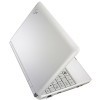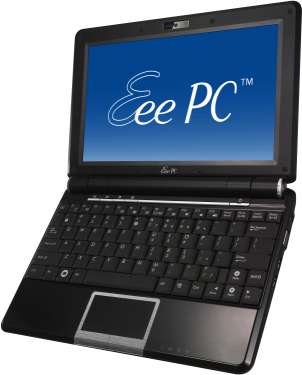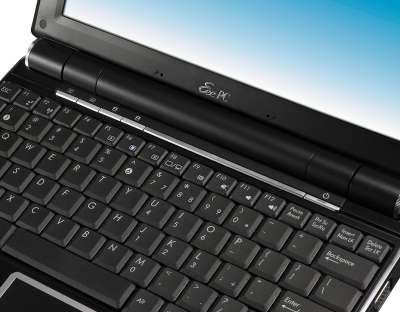- Qualcomm Launches Snapdragon 4 Gen 2 Mobile Platform
- AMD Launches Ryzen PRO 7000 Series Mobile & Desktop Platform
- Intel Launches Sleek Single-Slot Arc Pro A60 Workstation Graphics Card
- NVIDIA Announces Latest Ada Lovelace Additions: GeForce RTX 4060 Ti & RTX 4060
- Maxon Redshift With AMD Radeon GPU Rendering Support Now Available
ASUS Eee PC 1000HA Netbook

With a countless number of netbooks available, we’re looking to see if the originator of them all still has what it takes to deliver a model that’s both affordable, and complete with the features we’re after. The 1000HA lacks the Bluetooth and Draft n of the 1000H, but still retains the same great looks, along with killer battery-life.
Page 1 – Introduction
When ASUS first launched their Eee PC last October, no one could have predicted what was to come. It was an instant-hit, and inspired other manufacturers to produce their own low-cost netbooks and ultra-mobile personal computers. However, since the beginning, ASUS has led this UMPC race by one-upping the competition with products of superior quality, usability, and ingenuity. The Eee PC 1000HA follows suit, and has much to offer, and little to disappoint.
The 1000HA arrived at our door in an attractive retail box, ready to function. I dissected the packaging and found myself staring back from the attractive, high-gloss finish on the paint of the Eee’s lid. The top-left corner of the lid has a tasteful cursive “Eee” logo. I also found that ASUS provided a small, neoprene-like, zippered pocket for the netbook. The pocket is pretty minimalist in itself, with just a zipper at the top, velvety outside, and Eee logo. Although a bit boring, it’s how I prefer my laptop cases; plain but functional.
The battery comes separated from the machine to prevent any incidental electrical shorts, but it’s truly a breeze to snap on. The battery adds a negligible bit of thickness onto the Eee, but with 6 cells, the thickness can be completely ignored when it comes to battery usage time.
The power brick was fairly plain as well, until I plugged it in. The calming blue LED power indicator on the brick is very bright… so bright that I had to cover it with electrical tape at night to avoid my room from having a dull electric-blue glow. Besides the slightly obnoxious LED indicator, the brick is tiny. About one-third the size of any brick I’ve used previously, it is much better for mobility. When I get to speaking about battery time, however, you’ll realize that you’ll be taking this adapter just about nowhere. The plug on the end of the cable is at a right angle, which is a desired characteristic of an adapter that plugs into the side of the netbook. This lets the cable trail behind the laptop, and doesn’t interfere with left-handed mouse users.
Taking a look at the outside of the netbook, we can see that the Eee has an attractive high-gloss finish. I’ve noticed that it’s a bit prone to fingerprints, but it’s just as easy to clean as it is to smudge. Thanks to a latch-less design, the Eee opens with little effort, but still manages to stay closed when in transit. Lurking around the sides of the netbook, you’ll find a total of three USB ports, one on the left, (near the Ethernet port,) two on the right.
You’ll also discover the audio ports, VGA output, and card reader. Unfortunately, I did not find the PCMCIA or ExpressCard slot I was hoping for. This nullifies most user’s abilities to upgrade their computer, mostly for networking card additions. Lastly, in the far left corner of the Eee PC, there is a fairly sturdy lock port. However, I never needed to use this, since the unit actually fit into one of my larger coat pockets, and even a cargo pant pocket if I was without my coat.
The bottom of the unit is fairly unremarkable, it has one large maintenance panel, and houses the speakers. I’m not sure where any manufacturer gets the idea that the speakers belong on the bottom of a netbook, but surprisingly enough, they sound alright, albeit a bit quiet.
Although the Eee PC is a UMPC, it boasts a fairly spacious keyboard, as well as a nice plot of palm-rest as a touchpad. The keyboard functions well, and lacks very little. The only thing that could be considered a con in this case would be the right shift key. In an effort to make typing more comfortable and keep the keyboard roomy, ASUS decided to move the right shift key above the arrow keys, specifically above the right arrow key. While I prefer to use the left shift key most often anyhow, it could really take some getting used to for individuals that aren’t addicted to only one shift key, or the right shift key.
To help with maximizing the space available, the Eee PC also lacks an optical drive, which is expected in a UMPC-like setup. Optical drives take up a surprising amount of space, and an even more surprising amount of power to operate. In the Eee PC’s case, ASUS decided to not include one. The situation can be easily remedied by using a flash drive, or even an external USB 2.0 optical drive.
Support our efforts! With ad revenue at an all-time low for written websites, we're relying more than ever on reader support to help us continue putting so much effort into this type of content. You can support us by becoming a Patron, or by using our Amazon shopping affiliate links listed through our articles. Thanks for your support!






